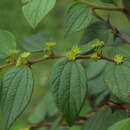ar
الأسماء في صفحات التنقل


Ziziphus oenopolia, commonly known as the jackal jujube, small-fruited jujube or wild jujube, is a flowering plant with a broad distribution through tropical and subtropical Asia and Australasia. In India, it is mostly found in the deciduous forests of the southern part of the country.
It is a spreading, sometimes climbing, thorny shrub growing to 1.5 m in height. The leaves are simple, alternate, ovate-lanceolate, acute and oblique. The flowers are green, in subsessile axillary cymes. The fruit is a globose drupe, black and shiny when ripe, containing a single seed.[2]
It ranges from the Indian subcontinent through southern China and Southeast Asia to northern Australia. It grows along roadside forests and thickets.[3]
The berries are edible and the bark is used for tanning.[3]
The plant produces cyclopeptide alkaloids known as ziziphines and has a long history of use as an herbal medicine. In India, the root is used in Ayurvedic medicine.[2] The Konkani people of Maharashtra use the chewed leaves as a dressing for wounds.[4] In Burma the stem bark is used as a mouthwash for sore throats, for dysentery, and for inflammation of the uterus.[5] Research in Thailand has found that extracts of ziziphine from Ziziphus oenopolia show antiplasmodial in vitro activity against the malarial parasite Plasmodium falciparum.[6]
 Leaves and fruits
Leaves and fruits  Flowers
Flowers Ziziphus oenopolia, commonly known as the jackal jujube, small-fruited jujube or wild jujube, is a flowering plant with a broad distribution through tropical and subtropical Asia and Australasia. In India, it is mostly found in the deciduous forests of the southern part of the country.